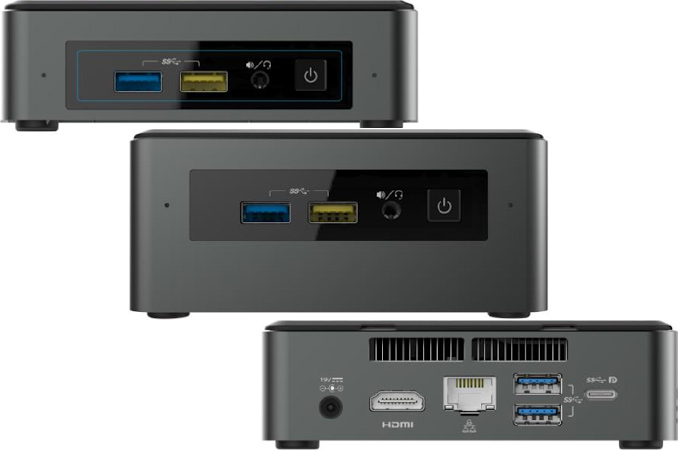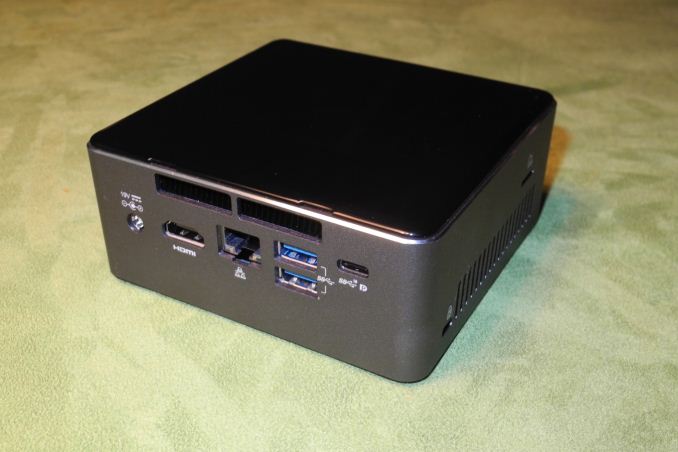Intel Officially Launches Baby Canyon NUCs with Kaby Lake: Thunderbolt Makes a Re-entry
by Ganesh T S on January 17, 2017 2:00 PM EST- Posted in
- Trade Shows
- Systems
- Intel
- HTPC
- NUC
- Thunderbolt 3
- Kaby Lake
- CES 2017

The Baby Canyon NUCs were leaked in July 2016, and Intel officially launched the units at CES 2017. The first-generation NUCs based on Ivy Bridge had a SKU with Thunderbolt support. However, Thunderbolt went missing till it came back in the Skull Canyon NUC (NUC6i7KYK) last year. The Alpine Ridge controller for Thunderbolt 3 also integrates a USB 3.1 Gen 2 controller, making the Type-C Thunderbolt 3 port quite versatile. The Baby Canyon NUCs bring Thunderbolt back into the UCFF NUC form-factor. All the Baby Canyon NUCs have the Alpine Ridge controller. However, the i3 model is limited by firmware, allowing the Type-C port to support only USB 3.1 Gen 2 and Display Port 1.2. The i7 and i5 models have full Thunderbolt 3 support.
The leaked specifications we wrote about in July were more or less accurate, and the official specifications allow us to fill in some of the missing blanks. The updated table is presented below. SKUs ending with K are units that do not support a 2.5" drive (only M.2 SSDs are supported).
| Intel Baby Canyon NUC PCs | |||||
| NUC7i7BNH | NUC7i5BNH | NUC7i5BNK | NUC7i3BNH | NUC7i3BNK | |
| CPU | Core i7-7567U 2C/4T 28 W TDP |
Core i5-7260U 2C/4T 15 W TDP |
Core i3-7100U 2C/4T 15 W TDP |
||
| Graphics | Intel Iris Plus Graphics 650 | Intel Iris Plus Graphics 640 | Intel HD Graphics 620 | ||
| PCH | Intel Sunrise Point-LP for Kaby Lake-U | ||||
| Memory | Two SO-DIMM slots, up to 32 GB of DDR4-2133 | ||||
| 2.5" bay | 1x2.5"/9.5mm bay, SATA3 | None | 1x2.5"/9.5 mm bay, SATA3 | None | |
| M.2 Slot | Up to M.2-2280 SSD with SATA3 or PCIe 3.0 x4 interface | ||||
| Wi-Fi/BT | Soldered-down Intel Wireless-AC 8265 (802.11ac 2x2 + BT 4.2) with WiDi support | ||||
| Ethernet | Intel I219V Gigabit Ethernet controller | ||||
| Display Outputs | DisplayPort 1.2 via USB-C connector HDMI 2.0 |
||||
| Audio | 3.5 mm TRRS audio jack 7.1 channel audio output via HDMI or DP |
||||
| Thunderbolt & USB-C |
1x Thunderbolt 3 Type-C (40 Gbps) (USB 3.1 Gen 2 and Display Port functionality included) | 1x USB 3.1 Gen 2 Type-C (with Display Port functionality included) | |||
| USB | 4 USB 3.0 Type-A (5 Gbps), one with charging | ||||
| Other I/O | MicroSDXC card reader with UHS-I support One infrared receiver |
||||
| Size (mm) | 115 × 111 × 51 | 115 × 111 × 31 | 115 × 111 × 51 | 115 × 111 × 31 | |
| PSU | External, 65 W | ||||
| OS | Compatible with Windows 7/8.1/10 | ||||
| Product Page | NUC7i7BNH Specifications | NUC7i5BNH Specifications | NUC7i5BNK Specifications | NUC7i3BNH Specifications | NUC7i3BNK Specifications |
In terms of appearance, the chassis sides now have a shade of gray to provide a better look when seen along with the black lid. We have a micro-SDXC slot on the side (a full-sized SDXC slot couldn't apparently work with their thermal design). In terms of performance, Kaby Lake should provide the claimed 7 - 11% improvement over the corresponding Skylake products. The new NUCs are also Optane-ready - allowing Optane M.2 SSDs to work seamlessly in conjunction with 2.5" hard drives in the future (when the Optane SSDs come into the market). One important thing to note here is that the i7 model uses a 28W TDP SKU (the Core i7-7567U), compared to the 15W TDP SKUs used in the i3 and i5 models. The i7 and i5 models have Iris Plus graphics with 64MB of eDRAM. None of the Baby Canyon NUCs support vPro. HDMI 2.0 with HDCP 2.2 is supported, thanks to the inclusion of a LSPCon in the BOM. This should make the units into perfect HTPCs with Netflix 4K capability. Compared to the NUCs from the last few generations, these units are not a big upgrade in terms of unique features for other use-cases. Generally speaking, we are not convinced that the Optane-ready feature is a big enough reason to upgrade to the Baby Canyon NUCs. That said, the i7 model should prove pretty interesting to compare against the Broadwell-U Iris NUC.
The NUC7i3BNH with the neutered Alpine Ridge Controller
(Note that the Type-C port only carries the SS10 / DP logos)
Intel indicated that the kits are slated to come into the market over the next few months at price points similar to the current Skylake versions. While official MSRPs were not provided, we see the NUC7i7BNH for pre-order at $700, the NUC7i5BNH at $610, and the NUC7i3BNH at $496.











70 Comments
View All Comments
Samus - Tuesday, January 17, 2017 - link
Still sucks there are no physical quad core models like the Skull Canyon model or whatever it was called. That thing was really amazing in potential, had it not been let down by its graphics component.nowayandnohow - Wednesday, January 18, 2017 - link
I have the skulltrail one, and thought all the specs look great, it is still just a glorified laptop. It's awesome to be able to put the machine in my backpack and basically it weights no more than a book of similar size, and I have every connector in the world available to me, dual M.2's, qudchannel RAM... It is not made for gaming, and anyone thinking that they are should perhaps rethink their strategy. This is a compromise, as is the macbook pro: You want a sleak, sexy, Intel made computer - here you go - you want to bitch and moan about what it doesn't have and how expensive it is; then you are not the target, and should be building your own or buy a full sized desktop.beginner99 - Wednesday, January 18, 2017 - link
Price seems very steep. I mean for about $550 I can get a skull trail NUC now. Yeah it's bigger but also has TB 3 and a much faster CPU and GPU. Downside is lack of hardware decode for 4k.eldakka - Wednesday, January 18, 2017 - link
" Optane-ready - allowing Optane M.2 SSDs to work seamlessly in conjunction with 2.5" hard drives"Nonsensical statement.
An Optane SSD as an NVMe SSD that uses Optane NVRAM instead of NAND-based NVRAM.
Any computer that supports an NVMe SSD will support an Optane SSD, therefore a computer doesn't have to be 'Optane-ready' to use an Optane SSD.
Where the confusion I think comes in is in Optane _RAM_. Intel has spoken about being able to slot in Optane RAM sticks into RAM slots. Perhaps 'Optane ready' means it will support this.
close - Wednesday, January 18, 2017 - link
Not quite so simple:"2Intel® Optane™ Memory and its logo denote a platform feature made up of individual components and not solely a single small factor solid state drive or a memory media. A system that is Intel® Optane™ memory ready includes: an 7th Gen Intel® Core™ or Xeon® E3 v6 processor1, an Intel® 200 series2 or 100/C230 series3 (HM175, QM175, or CM238) chipset, M.2 type 2280-S1-B-M or 2242-S1-B-M connector on a PCH Remapped PCIe* Controller and Lanes in a x2 or x4 configuration with B-M keys that meet NVMe Spec 1.1 and System BIOS that supports the RST 15.5 driver.
Support limited to Intel® S-, H-, and U-series processors.
Only supported on 7th Gen Intel® Core™ or Xeon® E3 v6 S-series processors.
Only supported on 7th Gen Intel® Core™ or Xeon® E3 v6 H-series processors."
This isn't "just another NVMe SSD". Nor is this the difference between an SSD with planar NAND vs an SSD with 3D NAND. That's why initial Optane offerings come in sizes of... 16 and 32GB. This isn't primary storage, it's used for caching of data including data needed at boot time. So unless you can find another way to tell your OS to cache data on that device and also use it at boot lets just go forward on the assumption that this can be viewed just like SRT. It needs both hardware and software support to run and it runs *in conjunction* with your primary storage.
damianrobertjones - Wednesday, January 18, 2017 - link
"DisplayPort 1.2 via USB-C connector"Another new cable to buy :( I have drawers full of the things.
P.s. I'd imagine the price to rise slightly as that's the aim: Each new gen gets more expensive.
nowayandnohow - Wednesday, January 18, 2017 - link
No, the point s that you don't have a gigantic array of ports in the front or back. Anything you need can be done with a dongle, USB3, USB 3.1, TB3. If you want loads of old, large and dust eating ports - buy a desktop.damianrobertjones - Monday, January 23, 2017 - link
My point stands... I STILL have to buy a new cableThe_Assimilator - Wednesday, January 18, 2017 - link
Intel, stop trying to make Thunderbolt happen. IT'S NOT GONNA HAPPEN. At least, not unless you make it ubiquitous by (a) not charging an arm and a leg for it (b) stop gimping it on lower-end models.At this point, however, Thunderbolt is destined for the same fate as Firewire: overpriced Mac junk.
utmode - Wednesday, January 18, 2017 - link
@The_Assimilator+1.
no body buys TB device. I haven't seen any body has it.